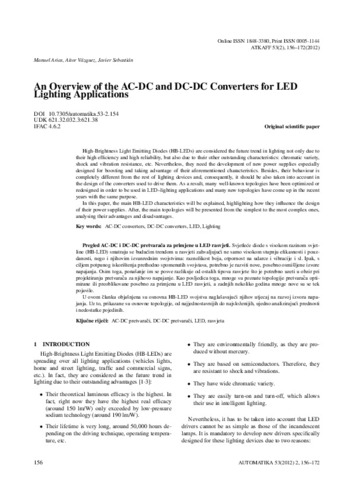An overview of the ac-dc and dc-dc converters for LED lighting applications
Autor(es) y otros:
Fecha de publicación:
Citación:
Descripción física:
Resumen:
High-Brightness Light Emitting Diodes (HB-LEDs) are considered the future trend in lighting not only due to their high efficiency and high reliability, but also due to their other outstanding characteristics: chromatic variety, shock and vibration resistance, etc. Nevertheless, they need the development of new power supplies especially designed for boosting and taking advantage of their aforementioned characteristics. Besides, their behaviour is completely different from the rest of lighting devices and, consequently, it should be also taken into account in the design of the converters used to drive them. As a result, many well-known topologies have been optimized or redesigned in order to be used in LED–lighting applications and many new topologies have come up in the recent years with the same purpose. In this paper, the main HB-LED characteristics will be explained, highlighting how they influence the design of their power supplies. After, the main topologies will be presented from the simplest to the most complex ones, analysing their advantages and disadvantages
High-Brightness Light Emitting Diodes (HB-LEDs) are considered the future trend in lighting not only due to their high efficiency and high reliability, but also due to their other outstanding characteristics: chromatic variety, shock and vibration resistance, etc. Nevertheless, they need the development of new power supplies especially designed for boosting and taking advantage of their aforementioned characteristics. Besides, their behaviour is completely different from the rest of lighting devices and, consequently, it should be also taken into account in the design of the converters used to drive them. As a result, many well-known topologies have been optimized or redesigned in order to be used in LED–lighting applications and many new topologies have come up in the recent years with the same purpose. In this paper, the main HB-LED characteristics will be explained, highlighting how they influence the design of their power supplies. After, the main topologies will be presented from the simplest to the most complex ones, analysing their advantages and disadvantages
ISSN:
Patrocinado por:
This work has been supported by Spanish Government under projects RUE-10-CSD2009-00046 FEDER Funds, MICINN10-DPI2010-21110-C02-01 and student grant FPI BES-2011-044114
Colecciones
Ficheros en el ítem




